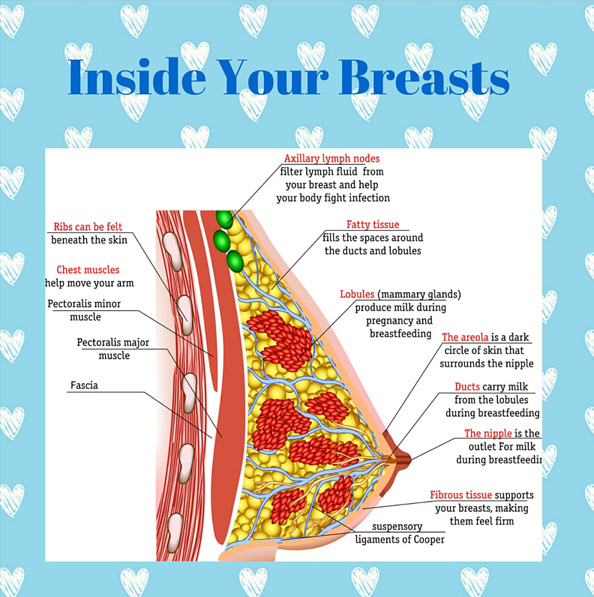What are breasts made of?
#anxiety, #boobs
Regardless of what’s going on in the inside with those pesky hormones that you can’t see, breasts are one of the most obvious signs that you are becoming a woman to you…and everyone else around you!
When you were a little girl, your chest was flat and they looked no different to boys, now you are getting older your body is changing and breasts often start to grow from the age of 7 upwards.
But what are breasts made of?
Let’s take a closer look at these parts of the breast for more information on what they do!

- Fatty Tissue - during your teens and early twenties and when the breasts are developing they may feel quite firm and dense, they become softer as you age. You can see from the yellow sections in the diagram that breasts contain quite a lot of fatty tissue, this means they can increase or decrease in size depending on weight gain or loss.
- Breasts themselves contains no muscle, so don’t be fooled into thinking you can do any form of exercise to make your breasts fuller. There are however muscles that lie behind the breast (Pectoralis minor and major) that help support the breast itself and very often it is the firmness of these muscles that helps keep the breasts lifted and in shape.
- The lymph nodes are tiny in size; about 1cm and their job is to filter any excess fluid from your breast and to help your body fight infection.
- Lobules sometimes referred to as your mammary glands are a few millimetres long and hollow. And this is where breast milk is produced and stored.
- Ducts almost look like tree branches within the breast and are responsible from carrying milk from the lobules to the nipple, in order to breast feed.
- As you enter puberty you may notice that the circle surrounding your nipple starts to become larger and darker in colour. This is called your Areola no one really knows why this area changes colour during puberty, but many experts believe it is to make this area more visible to an infant allowing it to find the nipple when breast feeding. Remember there is no right or wrong size or colour for this area to be, we are all different.
- You may start to notice little spot like lumps on your areola, these are called Montgomery glands and just like the body produces oil to keep your scalp and face moisturised, these glands do the same for your nipple and areola.
- To put it plainly the nipple is there to help deliver milk from the lobules to a baby. But it is very sensitive and has many nerve endings, this is why when you are cold or the nipple is rubbed it can become hard and stand out.
Next time we will answer some of the most popular questions about breasts and their development.
See Also
Breast Buds